How To Learn How To Draw Portraits
The Footstep-by-Step Guide on How to Describe a Portrait
Past Vladimir London
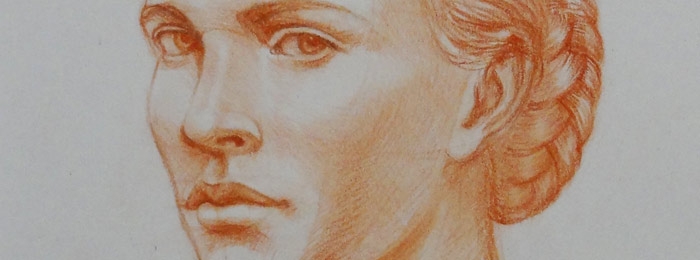
In this book, you volition notice the pace by step procedure of how to draw a head in the three-quarters view.
It is written and illustrated by Vladimir London, internationally published author and the founder of Drawing University.
Preface
In the Cartoon Academy form, students often ask me how to depict a portrait so it looks realistic. I too regularly receive portrait drawings for critique that take common mistakes similar misplaced facial features, incorrect proportions, wrong perspective, and so on. Such mistakes happen because of:
- Not knowing or not post-obit constructive drawing principles
- Ignoring human being head proportions
- Knowledge gaps in a human anatomy.
The biggest challenge in drawing portraits arrives from the misconception of how art is created – students describe not what they know, but copy what they see. This leads to inevitable mistakes.
To explain why the principle "Depict What You lot Know, not What You Come across" is of import, I'll give you lot an example. When drawing from life, art students are doing their all-time to draw optics, nose and rima oris as they see it on a model, forgetting, nonetheless, the overall construction of the head. It is like decorating walls before building a house.
To "build" a caput in portrait drawing requires much more than than merely copying what y'all see. And the necessary know-how but comes with crucial knowledge. Y'all simply won't see the definiteness of proportions if you don't know what those proportions are.
So, in this serial of manufactures, I will share with you lot the in-depth step-by-step know-how of portrait drawing equally information technology's taught in 1 of the World's best art institutions – Repin Academy in St. Petersburg, Russia. This procedure is also described in my volume "How to Describe a Portrait in the Iii Quarters View" bachelor on Amazon.
Here'southward how the finishes sketch looks. You will exist able to draw like portraits past the end of this exercise should you follow closely my instructions.

This quick cartoon was done in red pastel pencil; nonetheless, feel free to use whatsoever cartoon medium of your choice. It is non about color, but constructive drawing principles, rules of perspective, head proportions and anatomy, which won't alter whether you depict in graphite pencil, charcoal or with your finger on sand.
How to Draw a Portrait in the Three Quarters View
Earlier drawing begins
I would suggest getting a model or drawing a self-portrait looking in a mirror.
Showtime, clarify the head, chose the view bending, and decide on the artwork size and layout. Fix paper to a drawing board and get your pencil sharpened.
i. First stride
Begin with measuring the master proportion of the model's caput – its width-to-height ratio using a pencil or by eye. Many fine art students enquire me how to measure out with a pencil; to respond, I created this commodity – //drawingacademy.com/how-to-measure-with-a-pencil
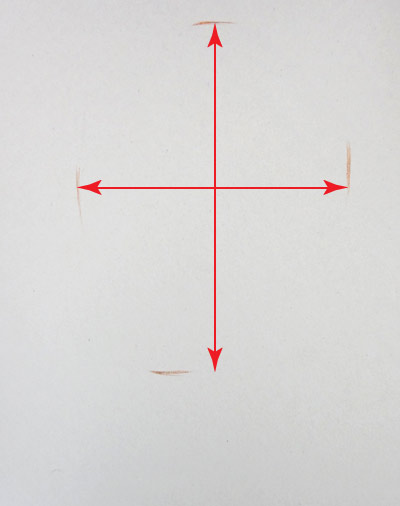 This proportion varies depending on the view angle. Brand sure to get it as accurate every bit you tin can.
This proportion varies depending on the view angle. Brand sure to get it as accurate every bit you tin can.
When y'all have this ratio measured, decide on a composition of your future portrait – how big the head would be and where on newspaper it will be located.
Mark 4 strokes – the top, bottom besides equally the left and right edges of the caput. Make sure there is enough space in front of the head – "olfactory organ room" and the head is not too close to the top edge of paper. It is likewise good to have more space below the head than higher up.
Train your eyes by mark those edges freehand and, if necessary, double-cheque the main proportion using a pencil.
2. Dividing the face into three parts
The adjacent step requires a know-how of the universal proportion of the face. All adult faces regardless of individual appearances share the same proportion – the distance between the hair-root line and the bottom border of the chin can exist divided in iii equal parts:
- From the hair-root line to the eyebrow line
- From the eyebrow line to the base of operations of the olfactory organ
- From the base of operations of the olfactory organ to the bottom of the chin.
 Find on the model where the pilus-root line is intended by nature and mark this line on the drawing. Divide the altitude from that line to the bottom of the head into three equal parts past heart or using a pencil as a measuring stick. Do it equally accurate equally yous can; precise location of these iii parts will assist you lot in placing facial features correctly.
Find on the model where the pilus-root line is intended by nature and mark this line on the drawing. Divide the altitude from that line to the bottom of the head into three equal parts past heart or using a pencil as a measuring stick. Do it equally accurate equally yous can; precise location of these iii parts will assist you lot in placing facial features correctly.
If the model'southward caput is on the same level equally yours, yous would see those three lines horizontal. When the model is located higher than a viewer, lines will exist curved upward. The opposite is also true – lines will be curved down when a model's head is located lower. The curvature depends on the view angle.
To keep things simple for this exercise, nosotros describe a portrait at our center-level.
3. Placing the eye-line
The following step comes from the know-how – this proportion is not measured on a model's head, it is universal for all portraits – the heart-line divides the elevation of the caput in half.
And then, we tin can place the middle-line with confidence, mark it either freehand or using a pencil to measure where the middle of the head is.
This horizontal line, of form, will be located below the eyebrow line that we marked in the previous step.
 I have to make a disclaimer that the eye-line can exist tilted or curved depending on a view angle. In such case, you need to go on in heed that distances of this proportion could be foreshortened in perspective and the top border of the head in your drawing might not correspond to the actual summit point of the model's caput. And then, if we encounter a caput from above, the center-line would exist curved downward and appear lower than the actual eye point between the top and bottom marks of the head.
I have to make a disclaimer that the eye-line can exist tilted or curved depending on a view angle. In such case, you need to go on in heed that distances of this proportion could be foreshortened in perspective and the top border of the head in your drawing might not correspond to the actual summit point of the model's caput. And then, if we encounter a caput from above, the center-line would exist curved downward and appear lower than the actual eye point between the top and bottom marks of the head.
If the paragraph to a higher place sounds a bit confusing, call back of a cylinder seen from above in perspective and imagine how its middle line curves downward and where information technology is located in relation to the cylinder'southward top and bottom edges. To guide yous through the challenging topic of how to draw in perspective, I created this gratuitous video lesson – //drawingacademy.com/drawing-in-perspective
4. Base of the skull and border of the cheekbone
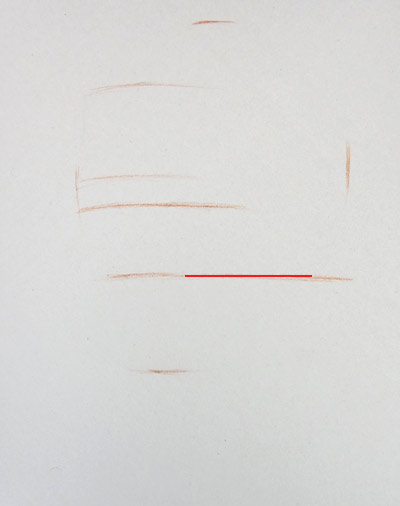 Location the plane of the skull base volition assistance u.s.a. to connect the head, neck and shoulders correctly. This plane is on the same level as the base of the nose, which as well corresponds to the bottom edge of the cheekbone. This level is marked in red line.
Location the plane of the skull base volition assistance u.s.a. to connect the head, neck and shoulders correctly. This plane is on the same level as the base of the nose, which as well corresponds to the bottom edge of the cheekbone. This level is marked in red line.
5. Lower office of the cranium
 In this step nosotros mark the location of the lower part of the cranium. Although information technology might be subconscious by long hairs or a tall collar nosotros do it using one of the constructive drawing principles – cartoon objects as if they are transparent.
In this step nosotros mark the location of the lower part of the cranium. Although information technology might be subconscious by long hairs or a tall collar nosotros do it using one of the constructive drawing principles – cartoon objects as if they are transparent.
6. Locating the eyebrow
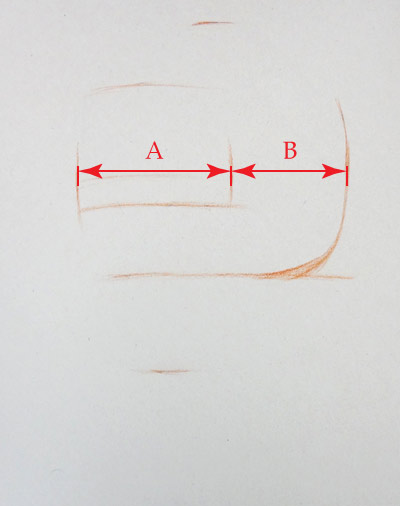 The eyebrow'southward edge is an important mark of the head. This virtual line marks the caput's planes, separating the face from the side of the head. This edge also serves as a edge between tonal values of low-cal and shade.
The eyebrow'southward edge is an important mark of the head. This virtual line marks the caput's planes, separating the face from the side of the head. This edge also serves as a edge between tonal values of low-cal and shade.
The countenance'southward edge location depends on the angle of view. It has to be measured on the model by comparing distances "A" and "B".
Later on, this border volition also help u.s.a. to determine the position of the ear.
7. Defining contours of the face
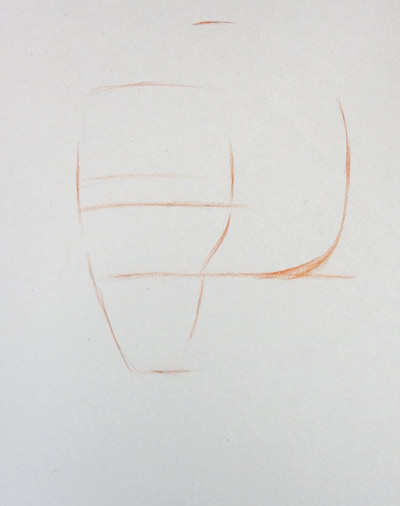 Contours of the confront are very of import virtual lines that assist to define portrait'due south likeness.
Contours of the confront are very of import virtual lines that assist to define portrait'due south likeness.
A profile should not be confused with an outline. In the drawing below, contours of cheekbones and jawlines are marked equally contours. These lines are private; angles of which take to be measured on the model. Contours here describe the shape of the model'south face.
8. Indicating the top border of the ear
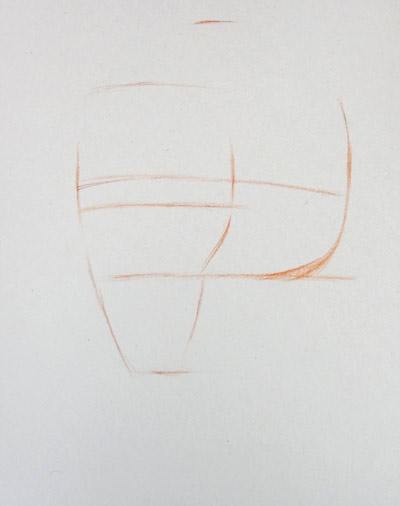 Unlike in previous pace, where contours of the face are individual, location of the superlative border of the ear is universal for all portraits. This edge is on the same level as the eyebrows line. To marking the top of the ear, we extend the eyebrows line horizontally towards backside of the head.
Unlike in previous pace, where contours of the face are individual, location of the superlative border of the ear is universal for all portraits. This edge is on the same level as the eyebrows line. To marking the top of the ear, we extend the eyebrows line horizontally towards backside of the head.
9. How to identify the ear correctly
 Equally the Drawing Academy tutor, I oft receive for critique portrait drawings that take i common error – a miss-located ear. To avoid such a junior mistake you need to know the post-obit rules:
Equally the Drawing Academy tutor, I oft receive for critique portrait drawings that take i common error – a miss-located ear. To avoid such a junior mistake you need to know the post-obit rules:
- The elevation of an ear is on the same level every bit the line of eyebrows.
- The bottom edge of an ear is on the same level as the base of the nose.
- The distances from the edge of the eyebrows to the ear and to the middle of the face are equal (marked by "C" in green). In perspective, these distances will be foreshortened. This is the same distance every bit between the hair-roots and the eyebrows line, the eyebrows and the base of the nose, and the base of the nose and the chin (marked by "C" in cherry-red).
- The line where an ear connects to the head is not vertical only tilted astern (blueish line).
10. Placing the pit of the cervix
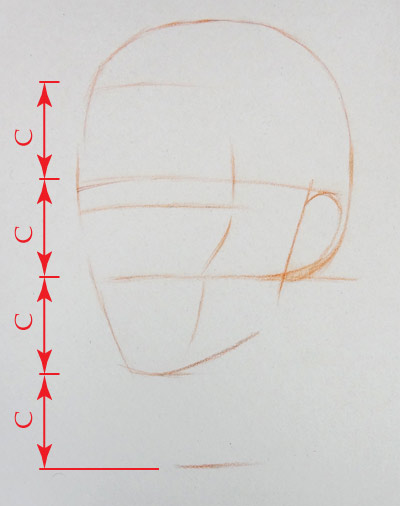 Some other common mistake art students brand is forgetting about the neck and drawing it as an afterthought when the caput is fully drawn. It is near incommunicable to describe believable looking portraits from life or imagination without the noesis of a head and shoulders beefcake.
Some other common mistake art students brand is forgetting about the neck and drawing it as an afterthought when the caput is fully drawn. It is near incommunicable to describe believable looking portraits from life or imagination without the noesis of a head and shoulders beefcake.
Let's signal an of import landmark of the portrait – the pit of the neck. It is located between ii collarbones just above the breastbone.
The altitude from the chin to the pit of the cervix is equal to the one-3rd proportion of the face (marked past "C" in red).
11. Why sternocleidomastoid musculus is important in portrait cartoon
 The muscle with a very long proper name, sternocleidomastoid, is an important landmark when it comes to cartoon a cervix. Information technology connects the top part of sternum (breastbone) and clavicle (collarbone) with the base of operations of the skull called mastoid – the process of the skull positioned only behind the ear.
The muscle with a very long proper name, sternocleidomastoid, is an important landmark when it comes to cartoon a cervix. Information technology connects the top part of sternum (breastbone) and clavicle (collarbone) with the base of operations of the skull called mastoid – the process of the skull positioned only behind the ear.
We draw this muscle diagonally. In drawing, this muscle not only defines the shape of the cervix just also separates its frontal part from the side plane.
12. Trapezium
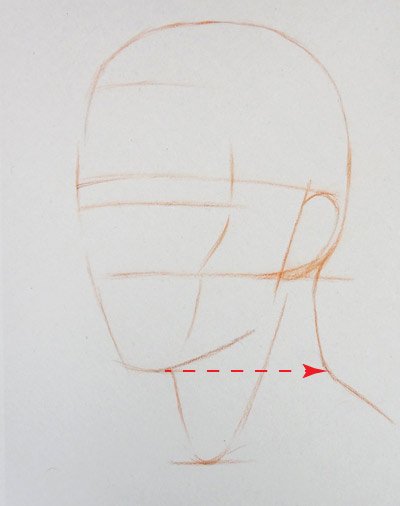 The trapezium is another of import muscle that defines the shape of the backside of the neck.
The trapezium is another of import muscle that defines the shape of the backside of the neck.
At that place is one point you need to define when drawing a neck in the iii quarters view – the place where the neck changes into the angle of trapezium. This point is on the same level every bit the bottom border of the chin; see the dotted line on the drawing below.
thirteen. Outlines of the neck and collarbones
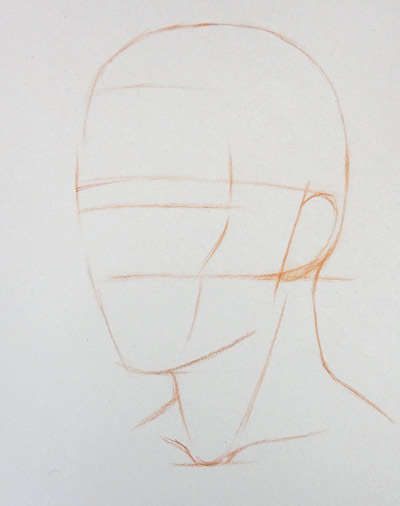 Following the constructive cartoon principles, we draw not what nosotros see, but what we know. This fully applies to collarbones, which can be covered past model's dress.
Following the constructive cartoon principles, we draw not what nosotros see, but what we know. This fully applies to collarbones, which can be covered past model's dress.
In perspective, the axes of collarbones announced foreshortened and tilted. The pair of collarbones is curved like a cupid's bow or a stretched double "S". Information technology connects the breastbone with the shoulder blades.
Outlines of the cervix are individual and you have to detect its shape on the model.
It is a adept approach to draw shoulders equally 1 continuous line from one shoulder to another, making sure they are on the aforementioned level and look natural.
14. Drawing the base of the neck
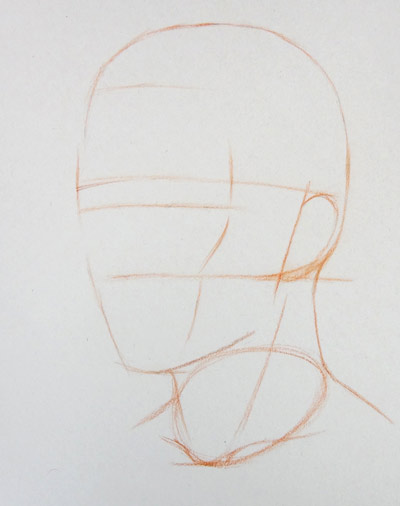 When main outlines and contours of the cervix in place, nosotros can marking the base of the neck. It has a circular shape and in perspective appears as a tilted oval. This oval goes through the top pair of ribs and defines the width of the neck at its base. This oval also marks the size of the height of the ribcage.
When main outlines and contours of the cervix in place, nosotros can marking the base of the neck. It has a circular shape and in perspective appears as a tilted oval. This oval goes through the top pair of ribs and defines the width of the neck at its base. This oval also marks the size of the height of the ribcage.
The base of operations of the neck is an important contour considering it separates vertical planes of the neck from more horizontal surfaces of the shoulders. As such, it serves as a edge between light and shaded areas of those surfaces.
xv. Rendering the main shades of the portrait
 So far, we do non depict any facial features or small details. Instead, we build a solid construction of the head in cartoon. This will aid united states of america to avert mistakes and misplacements when information technology comes to drawing facial features. Drawing eyes, mouth, nose, etc. at this stage is like decorating the walls before edifice a firm.
So far, we do non depict any facial features or small details. Instead, we build a solid construction of the head in cartoon. This will aid united states of america to avert mistakes and misplacements when information technology comes to drawing facial features. Drawing eyes, mouth, nose, etc. at this stage is like decorating the walls before edifice a firm.
Although this is a very general outline of the head, it is a time to cake-in the chief shades of the portrait.
Employ very calorie-free pencil pressure level to render shaded areas of the caput and neck.
16. Drawing outlines of the eyebrow
 Bank check model's forehead and eyebrow outline – information technology will exist individual to every person.
Bank check model's forehead and eyebrow outline – information technology will exist individual to every person.
Notice how this outline is protruding in front of the forehead – this altitude is indicated in blue lines on the drawing below.
The eyebrow outline has its feature angle (marked in ruby-red lines).
17. Outlines of the cheekbone
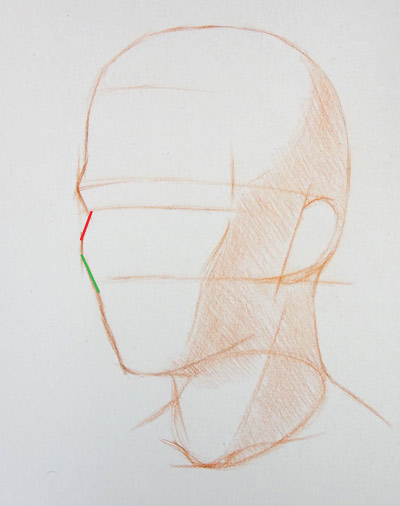 We move down along the contour of the face, this time paying attention to the individual contour of the cheekbone.
We move down along the contour of the face, this time paying attention to the individual contour of the cheekbone.
Once again, check this outline on the model; pay attention how far it bends and compare to the outline of the eyebrow. Usually, the countenance would be extended forward a bit more than than the outline of the cheekbone.
The eye socket outline depicted in the previous pace continues downward with the cheekbone outline.
You can also need to check the management of the line that goes towards the jawbone (indicated in green on the drawing below).
18. Parallel contours of the chin
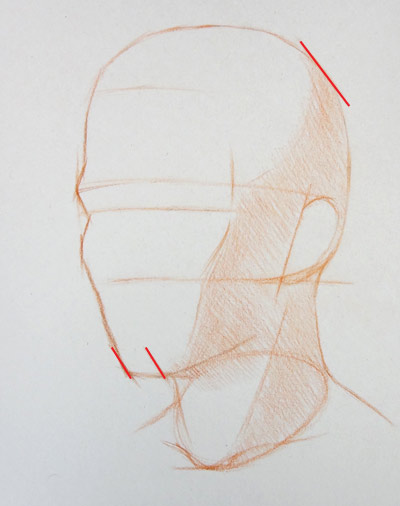 Usually, female chin is less pronounced than a male one; even so, both male person and female jaws take characteristic direction of outlines that can be marked in two parallel lines, which are as well parallel to the line of the back of the caput (marked in scarlet).
Usually, female chin is less pronounced than a male one; even so, both male person and female jaws take characteristic direction of outlines that can be marked in two parallel lines, which are as well parallel to the line of the back of the caput (marked in scarlet).
19. Drawing the eyebrow curve
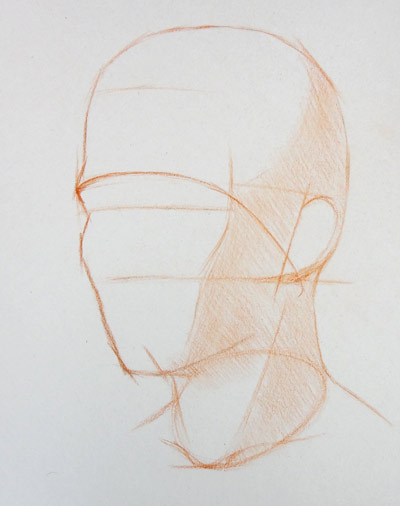 In a human caput, the edge between the cranial part of the skull, which protects the brain, and the facial part of the skull can be indicated past a curved virtual line that goes through the eyebrows and so sloped towards the ear channel.
In a human caput, the edge between the cranial part of the skull, which protects the brain, and the facial part of the skull can be indicated past a curved virtual line that goes through the eyebrows and so sloped towards the ear channel.
This virtual curved line helps to build properly the span of eyebrows, which is non straight, only bent downward.
20. Indicating the aeroplane under the eyebrows
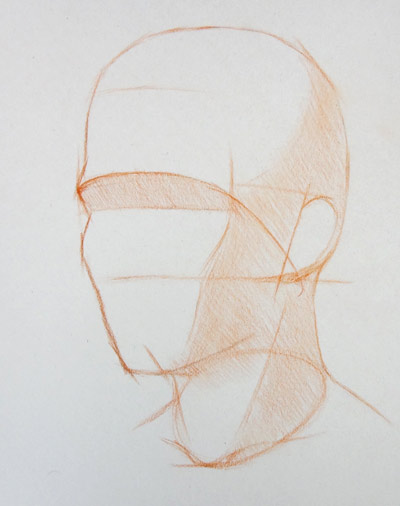 With the curved line of eyebrows divers, we can caw block shaded expanse below it. In nigh cases, the source of light is to a higher place a model'due south head, therefore information technology volition be a shade under eyebrows. So, nosotros marking this shade in light tone applying very light pencil pressure.
With the curved line of eyebrows divers, we can caw block shaded expanse below it. In nigh cases, the source of light is to a higher place a model'due south head, therefore information technology volition be a shade under eyebrows. So, nosotros marking this shade in light tone applying very light pencil pressure.
Every bit y'all see, we are nonetheless defining big masses without any attending to facial features similar optics, nose and oral fissure. Drawing such facial features before the chief shape of the head is build proficiently is like decorating walls of a firm that nevertheless to be constructed. This sequence will help you to ensure right proportions of the portrait and will result in greater likeness when we do the rest of the portrait.
21. Defining the cheekbones curve
 The cheekbones curve defines another important contour of the face. Information technology bends down from i cheekbone to another, with its lowest signal at the base of operations of the nose.
The cheekbones curve defines another important contour of the face. Information technology bends down from i cheekbone to another, with its lowest signal at the base of operations of the nose.
This virtual line is the border between the frontal part of the cheekbones and the upper jaw section.
A portrait artist tin but keep this line in mind rather than actually depict it. Nevertheless, as a part of the head construction, this line helps to "build" the portrait geometrically correct and proportionate.
22. Blocking the shade beneath the cheekbones' bend
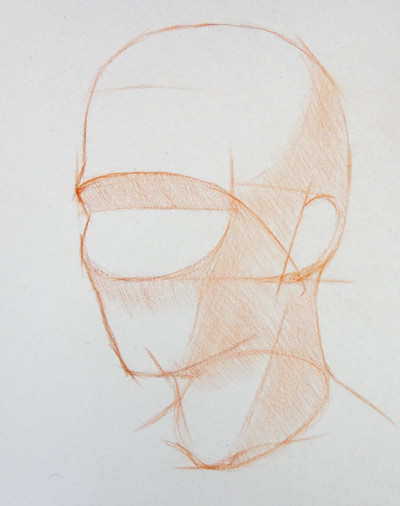 As mentioned before, the cheekbones curve separates two surfaces of the face. The surface of cheekbones higher up that line is facing the source of light and therefore volition announced lighter than the surface below.
As mentioned before, the cheekbones curve separates two surfaces of the face. The surface of cheekbones higher up that line is facing the source of light and therefore volition announced lighter than the surface below.
To indicate this departure in tonal values, we shade in very light pencil strokes the darker area correct below the cheekbones curve.
There is no demand to worry nigh exact tonal value of this plane right at present. All we want from this step is to show that two planes on both sides of the cheekbones bend have different tonal values. Nosotros volition fine-tune the exact tonal values subsequently on in this lesson.
23. Cartoon the fundamental line of the face
 A virtual line that goes exactly in the centre of a confront from the very top of the forehead to the bottom of the chin is one of the nearly important landmarks of every human face. It serves as the centrality of symmetry and is used to rest all facial features at the aforementioned distances from that line.
A virtual line that goes exactly in the centre of a confront from the very top of the forehead to the bottom of the chin is one of the nearly important landmarks of every human face. It serves as the centrality of symmetry and is used to rest all facial features at the aforementioned distances from that line.
Because the nose is located in front of this line, we can break the line or marker it very thinly within the nose area, so it would not interfere with lines of the olfactory organ afterwards.
Many cartoon books and tutorials suggest drawing a central line of the face up much before in a portrait drawing. The reason why nosotros do it now is because it is much easier, especially for beginners, to mark this line with precision when the overall construction of the head is in place.
I want to point once over again that the sequence of steps is a personal preference and some artists do not draw all virtual lines at all, keeping them in listen instead.
24. Mark contours of the eyebrows' corners
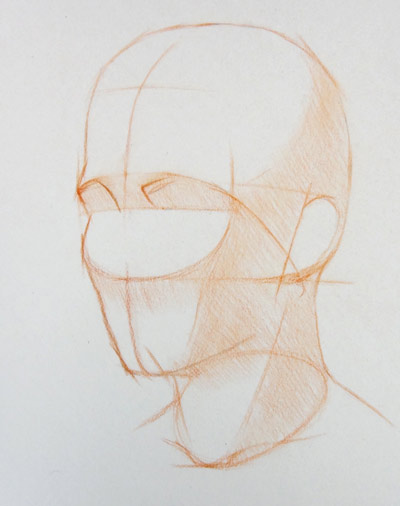 With the central facial line in place, we can continue by drawing smaller details making sure that facial features are symmetrical in relation to that line.
With the central facial line in place, we can continue by drawing smaller details making sure that facial features are symmetrical in relation to that line.
The shape of eyebrows is individual and yous need to observe its grapheme on the model first.
The bridge of the nose is bordering with the eyebrows corners, then we need to portray its width and bending.
25. Marking the upper eyelids' contours
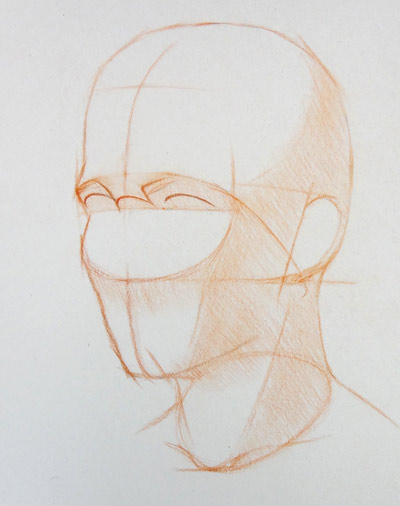 With the inner corners of eyebrows in place we can now mark the curvature of the span of the nose. This line is a helpful landmark, which usually coincides with the level of the upper eyelids contours. Considering every face is individual, you need to cheque this level on the model and adjust the drawing if required.
With the inner corners of eyebrows in place we can now mark the curvature of the span of the nose. This line is a helpful landmark, which usually coincides with the level of the upper eyelids contours. Considering every face is individual, you need to cheque this level on the model and adjust the drawing if required.
Symmetrical features like eyelids have to depict in pairs, making sure they are located on the same virtual horizontal line and accept similar curvature. This helps to avoid the mistake of cartoon one eye higher or lower than the other.
26. Shading the expanse above the upper eyelids
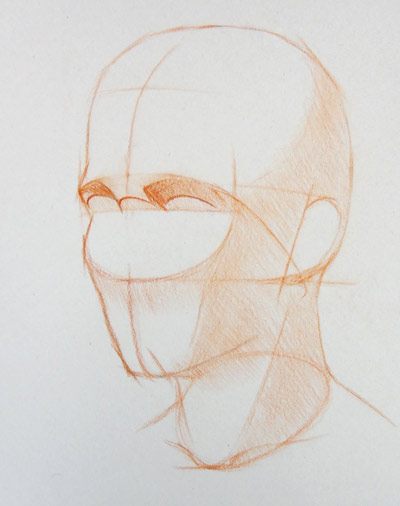 The area beneath eyebrows has darker tones than upper eyelids. And so, nosotros could build up tonal values to block the area higher up the eyes.
The area beneath eyebrows has darker tones than upper eyelids. And so, nosotros could build up tonal values to block the area higher up the eyes.
Go light with rendering upper eyelids. We volition come up back to darken these tonal values to required depth subsequently on. It is a good technique to build tones gradually. A adept way of applying pencil strokes is forth object's contours. Also, if you are drawing in graphite pencil, smudging pencil marks is a big no-no. I will explain why afterward.
27. Marking the corners of the eyes
Depicting eyes with precision is a critical stride in portrait drawing. It is not an easy task for beginners. I oft receive portrait drawings for critique with eyes that are besides close to each other or not symmetrical.
To pinpoint the exact location of eyes in a portrait drawing, you lot can utilize the post-obit rules:
- The altitude betwixt well-positioned eyes is equal to the length of one eye.
- Both eyes must exist on the same level, which is the horizontal line that divides the summit of the head in one-half.
 These rules are easy to utilize when you draw a full-face straight view portrait. In our case, it is a bit more complicated considering the caput is turned three-quarters and, therefore, is foreshortened in perspective. The center-line is as well slightly curved in this view.
These rules are easy to utilize when you draw a full-face straight view portrait. In our case, it is a bit more complicated considering the caput is turned three-quarters and, therefore, is foreshortened in perspective. The center-line is as well slightly curved in this view.
We begin with marking model left eye's corners. Check the distance from the key line of the face to the eye'due south inner corner. Make certain, this corner is non besides close to the nose in your drawing.
When this inner corner of the eye is pinpointed with necessary precision, you can also marker the wing of the olfactory organ, which is slightly closer to the fundamental line of the face. I marked the distance between the eye's corner and the nose border in red lines.
Check the length of the eye on the model and mark it in cartoon.
Echo this footstep for model'due south right center. In the three-quarter view, the olfactory organ tin overlap the inner corner of another eye. Depict this centre complete equally if the nose is transparent.
28. Depicting eyelids
 With all iv corners of optics in place, we can "build" eyelids with precision. I'k using the word "build" rather than "depict" because nosotros utilize constructive cartoon principles, cartoon what we know instead of copying what we encounter. This is especially critical when portraying eyes.
With all iv corners of optics in place, we can "build" eyelids with precision. I'k using the word "build" rather than "depict" because nosotros utilize constructive cartoon principles, cartoon what we know instead of copying what we encounter. This is especially critical when portraying eyes.
An eye is a ball about one inch in diameter and eyelids wrap effectually this ball. Despite an eyelid is a very thin muscle, it has certain thickness that has to be depicted.
At that place is 1 rule you must know to depict eyelids skillfully – upper and lower eyelids are non symmetrical. The upper eyelid has its top point i-third distance from the inner corner while the lower eyelid has the lowest point of its curve 1-3rd from the outer corner of the center. Avoid a junior mistake of cartoon tuna-shaped symmetrical eyelids.
This rule is easier to follow in directly view portraits. In our example, the upper eyelid is foreshortened in perspective. Nevertheless, the dominion is all the same in place.
29. How to Draw Optics
 With eyelids depicted accurately, we can identify an iris of the eye. Here's another amateur mistake you must avert – placing an iris as a full circle symmetrically between the upper and lower eyelids. Ordinarily, the upper function of an iris is partially covered past the upper eyelid while it might be a pocket-sized gap between the lower border of the iris the lower eyelid.
With eyelids depicted accurately, we can identify an iris of the eye. Here's another amateur mistake you must avert – placing an iris as a full circle symmetrically between the upper and lower eyelids. Ordinarily, the upper function of an iris is partially covered past the upper eyelid while it might be a pocket-sized gap between the lower border of the iris the lower eyelid.
Yous should also remember that the eyeball is non pure white and often has darker tonal values than highlights of the brow, for example. Also, there is a casted shadow under the upper eyelid.
Many fine art students ask me "how to draw eyelashes?" The professional way is not to depict individual eyelashes unless it is an advertising drawing for mascara. One night curved line would do the chore. This is especially of import for male portraits.
To learn more about how to draw eyes in this video lesson »
30. How to describe a olfactory organ
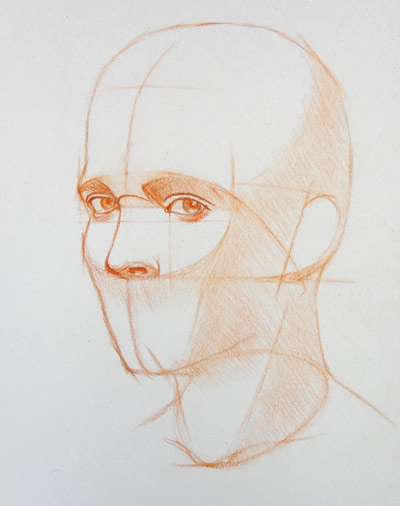 The shape of the olfactory organ can be simplified as a prism. The base of operations of the nose is already marked at the same level as the bottom edge of the ear and the span of the nose is curving between eyes. The width of the olfactory organ can be double-checked by comparing it to the distance between eyes.
The shape of the olfactory organ can be simplified as a prism. The base of operations of the nose is already marked at the same level as the bottom edge of the ear and the span of the nose is curving between eyes. The width of the olfactory organ can be double-checked by comparing it to the distance between eyes.
The individual shape of the olfactory organ has to be observed on the model. Shapes can vary from person to person and capturing likeness depends on how accurately you "build" model's nose contours and outlines.
First, y'all tin simplify nose contours as straight lines, depicting their angles and proportions. Then, you can smooth-up lines with softer corners.
The lower plane of the nose is in shadow and its tonal value can exist blocked in light tones for now. We will work on tonal values with necessary depth afterward.
31. How to place a mouth correctly
 When cartoon a oral fissure, there are some proportions you can yous to place it correctly.
When cartoon a oral fissure, there are some proportions you can yous to place it correctly.
We begin with placing the line between lips. This line is located one-third from the base of the nose to the bottom of the chin. This is an ideal proportion in existent life it cad differ, so you lot tin can measure this distance and suit if required.
If you lot draw an open mouth, keep in mind that the lower edge of the upper lip ordinarily would be at the halfway signal of the upper front teeth.
Of class, when cartoon a portrait in the three-quarters view, the line betwixt lips will appear in perspective and might non exist direct in your drawing.
32. Placing the lower lip
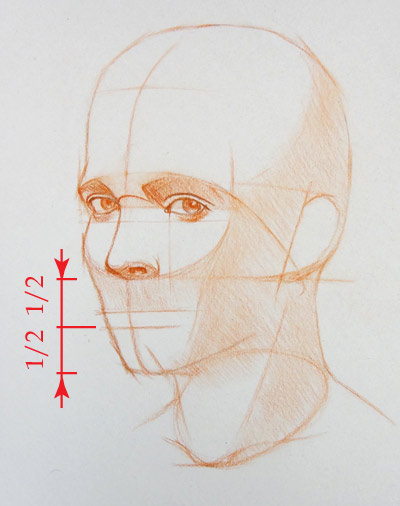 It is quite like shooting fish in a barrel to locate the bottom lip – its lower edge is exactly in the middle of the altitude from the base of the nose to the lesser edge of the chin. This proportion is too idealized and should be amended if your model is slightly unlike.
It is quite like shooting fish in a barrel to locate the bottom lip – its lower edge is exactly in the middle of the altitude from the base of the nose to the lesser edge of the chin. This proportion is too idealized and should be amended if your model is slightly unlike.
Avoid a inferior fault of placing the rima oris exactly in the middle betwixt the nose and the mentum. Information technology is really located in the upper half of this altitude.
33. Marking the upper lip
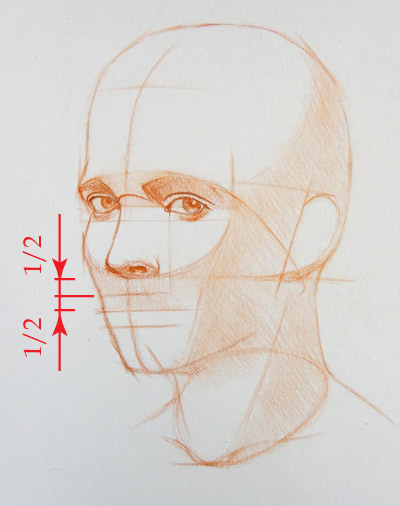 To locate the upper lip, just carve up the upper half of the distance from the olfactory organ to the mentum in half. Once again, this line is marked according to classical proportions.
To locate the upper lip, just carve up the upper half of the distance from the olfactory organ to the mentum in half. Once again, this line is marked according to classical proportions.
34. Blocking shades of the mouth
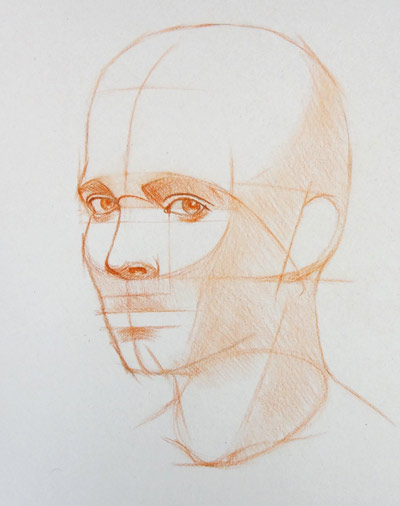 And then far, we take three parallel lines corresponding to the upper and lower edges of the rima oris and the line between lips.
And then far, we take three parallel lines corresponding to the upper and lower edges of the rima oris and the line between lips.
To indicate the form, we can slightly render shaded areas of the oral cavity, which are the upper lip and the place below the lower lip.
At this stride, we but differentiate planes of the mouth without going into details.
35. How to draw a oral cavity in a three-quarter view
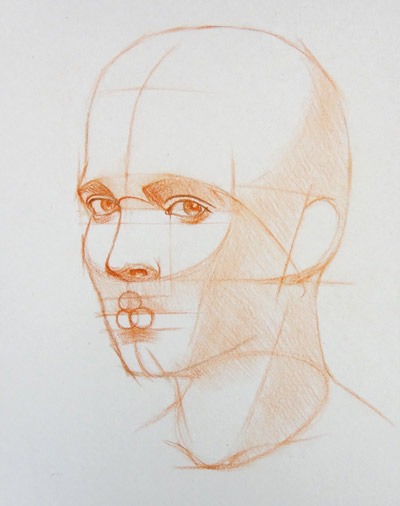 When information technology comes to draw a mouth in perspective, there are few things you need to keep in listen. Kickoff of all, information technology is important to draw what you know – the construction of the oral fissure, rather than copy what you see – outlines of lips. Copying leads to inevitable inferior mistakes.
When information technology comes to draw a mouth in perspective, there are few things you need to keep in listen. Kickoff of all, information technology is important to draw what you know – the construction of the oral fissure, rather than copy what you see – outlines of lips. Copying leads to inevitable inferior mistakes.
Here'southward what yous need to know. The mouth's construction has a three-dimensional nature. The upper and lower lips non only curved equally a cupid'south bow, resembling widespread characters "M" and "W", simply also curved from front to dorsum from the oral cavity heart to edges. This presents a certain challenge in 3-quarter drawing.
The half of the mouth that is further from the viewer will be considerably foreshortened in perspective, while another half volition be visible in without foreshortening.
In that location is one simple mode yous can use to overcome a challenge of cartoon a mouth. Depict three equal size balls – two at the bottom and one higher up them, all touching each other. These balls should be constructed in perspective, so one that is closer to the viewer might partially cover other balls. The upper ball sits in the center of the upper lip and two lower balls correspond to the lesser lip.
To learn more, check this video lesson on how to depict a mouth »
36. Drawing the oral fissure'due south outlines
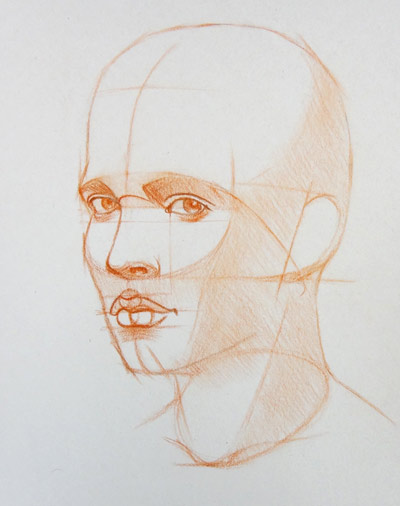 In previous step, we put three circles as the base of operations of the lips – two assurance for the lower lip and one above them. Now, these assurance can help u.s. to define the outlines of the oral fissure.
In previous step, we put three circles as the base of operations of the lips – two assurance for the lower lip and one above them. Now, these assurance can help u.s. to define the outlines of the oral fissure.
The top ball coincides with the central part of the upper lip. The upper lip's groove divides this ball approximately in half.
The bottom outline of the lower lip goes around ii balls, and the line between lips curves around all three balls, resembling a cupid'due south bow.
37. Defining the contours of the rima oris'south
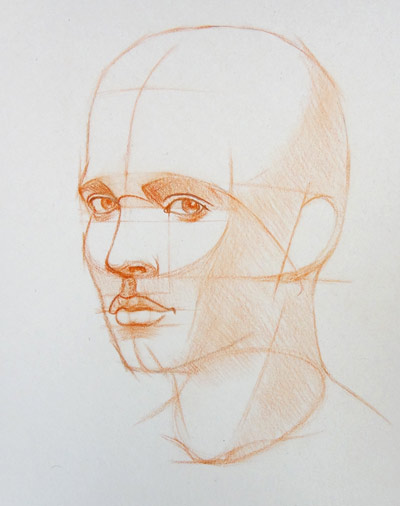 With master outlines of the moth in identify, we tin further ascertain contours of the oral fissure. At his step, virtual assurance of the oral cavity are redundant and can be erased altogether. This is the time to find model's mouth shapes and draw its individual shape, trying to achieve the necessary likeness.
With master outlines of the moth in identify, we tin further ascertain contours of the oral fissure. At his step, virtual assurance of the oral cavity are redundant and can be erased altogether. This is the time to find model's mouth shapes and draw its individual shape, trying to achieve the necessary likeness.
Brand sure that the linear perspective is in place and the one-half of the oral fissure that is further away from a viewer has more foreshortening than another half.
38. Virtual angles of the rima oris
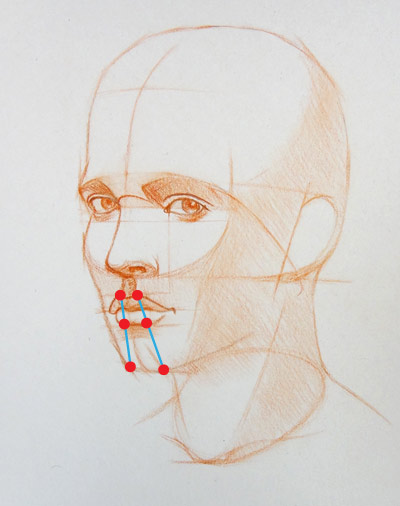 When defining the contour and outlines of the mouth, you can double-check angles that usually follow this rule – the upper lip top points, connected with the lower lip bottom points grade 2 lines that go diagonally to the prominent points of the chin. Every model has its individual shape of the mouth and chin, but in general, the upper lip protrudes more forward than the lower lip and the lower lip protrudes more than the chin. This protrusion is usually forms a trapezium plane that is based on six points of the chin and lips (marked with crimson dots).
When defining the contour and outlines of the mouth, you can double-check angles that usually follow this rule – the upper lip top points, connected with the lower lip bottom points grade 2 lines that go diagonally to the prominent points of the chin. Every model has its individual shape of the mouth and chin, but in general, the upper lip protrudes more forward than the lower lip and the lower lip protrudes more than the chin. This protrusion is usually forms a trapezium plane that is based on six points of the chin and lips (marked with crimson dots).
You can either draw those lines and dots or keep them in mind.
39. How to depict an ear
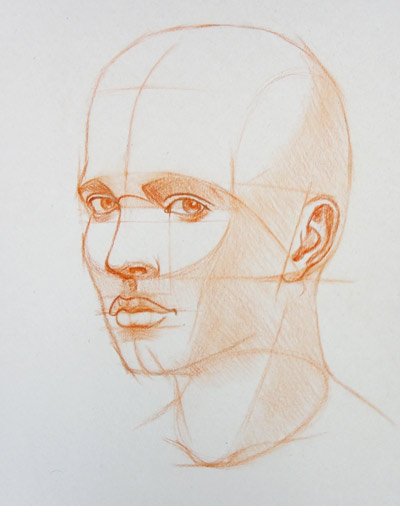 The ear's outline was marked a few steps earlier; information technology resembles the character "C." It's a proficient time to double-check its main proportion, which is the superlative of the ear is equal to the tiptop of the olfactory organ or the distance between the line of eyebrows and the base of the olfactory organ.
The ear's outline was marked a few steps earlier; information technology resembles the character "C." It's a proficient time to double-check its main proportion, which is the superlative of the ear is equal to the tiptop of the olfactory organ or the distance between the line of eyebrows and the base of the olfactory organ.
The ear'due south height divided in half will give us a dimension of the ear's width.
Further, we tin divide the height of the ear in three equal parts. Every role is as follows:
- At the superlative, at that place is the antihelix, which is the outer rim of the ear.
- The middle third coincides with the concha – the ear'southward basin.
- And the lower part is taken past the lobule.
The curve of the antihelix is echoed past another rim that is located inside and called the helix. At the top of the ear's bowl, the helix splits into ii arms like the character "Y".
You will discover more information on how to describe an ear in this video lesson »
xl. Defining the side plane of the head
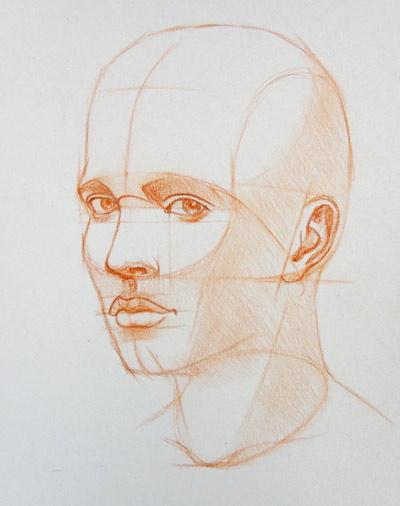 The curve where the forehead'south plane changes into the side plane of the head is an important "landmark". Normally, at this border tonal values will change from light to darker tones. This border can be marked before in cartoon and now we tin double-check its location and utilize light tonal shades to differentiate planes of the caput.
The curve where the forehead'south plane changes into the side plane of the head is an important "landmark". Normally, at this border tonal values will change from light to darker tones. This border can be marked before in cartoon and now we tin double-check its location and utilize light tonal shades to differentiate planes of the caput.
41. Shading the temple
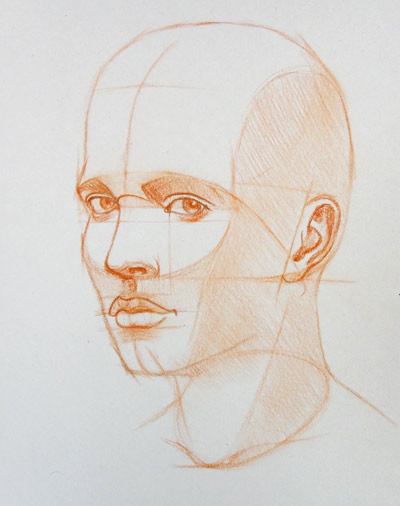 To separate the plane of the temporal os, nosotros tin shade its tonal value using wide strokes with light pencil pressure.
To separate the plane of the temporal os, nosotros tin shade its tonal value using wide strokes with light pencil pressure.
The direction of the strokes can go contours of that plane to emphasize its spatial position. There'southward no need to finish this part in i go, we volition come back to information technology later on to deepen the tonal values every bit required.
42. How to draw a hairstyle
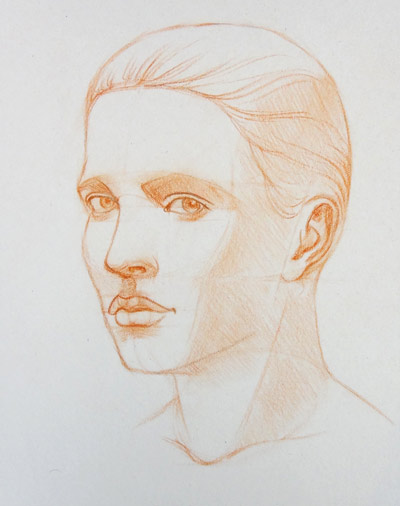 Up to this step, I've intentionally left the hairstyle untouched to demonstrate the planes and construction of the model's caput. Cartoon a assuming head is non required and you tin can signal the hair volume much before in the drawing.
Up to this step, I've intentionally left the hairstyle untouched to demonstrate the planes and construction of the model's caput. Cartoon a assuming head is non required and you tin can signal the hair volume much before in the drawing.
Students often ask me how to describe hairs. There are several points to keep in heed:
- Draw a hairstyle not as individual hairs, but equally one big mass.
- Construct planes of the hairstyle.
- Avoid rendering private curls in the start. Details volition come later.
- Employ pencil strokes along hairstyle contours, Do not doodle randomly.
- Render a hairstyle gradually; do not complete it earlier other parts of the portrait.
You will find much more data on how to draw hair hither »
43. How to render tonal values
 There are many approaches to rendering tonal values. Here, I will describe the classical way:
There are many approaches to rendering tonal values. Here, I will describe the classical way:
- It is improve to first from rendering big areas with the darkest tonal values.
- The process can develop gradually in multiple layers.
- The aim is to keep the drawing getting darker simultaneously in all places without finish one area before others.
- While shading, you need to keep an center on relative values, comparing different areas to each other.
- When drawing in graphite pencil, the pencil tip should be sharp at all times.
- Avoid going the full strength a drawing tool tin can provide from the starting time.
- Apply pencil strokes along the contours of objects.
- Reveal the volume of an object with strokes.
- Avert 90-degree cross-hatching unless you draw a drapery.
- Go on the gamut of pencil strokes rich and wide – use diverse directions of strokes, pencil pressure level, curvature and length of lines.
There are many more tips and professional demonstrations on how to render tonal values presented in the Drawing University video lessons »
44. Drawing small details
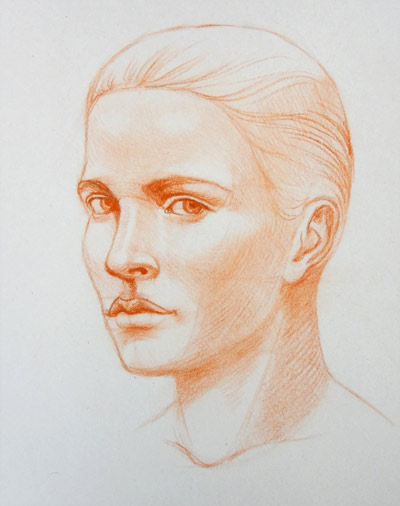 Working on a drawing goes from large areas to small details.
Working on a drawing goes from large areas to small details.
When working on smaller details, it is tempting to terminate some places earlier the residuum of the drawing. Professional person creative person keeps the whole drawing complete, merely non finished at all times until one decides that the creative task is accomplished.
Smaller details in a portrait are shaded using the same rules of rendering tonal values as when shading big areas; however, shorter pencil strokes are required for such task.
The good fashion of working on a portrait is when drawing goes from big areas to small details and then back to big areas again. Such bicycle can be repeated several times. This will ensure that a portrait looks unified yet detailed.
45. When to finish a head cartoon
 The beauty of working on a portrait rendering it gradually is that it would look completed at all times. So, it is your conclusion as an artist when to finish it. Yet, if you go out the drawing slightly unfinished, it would appear more interesting to a viewer. Overworking a cartoon is less desirable than stopping merely before you think it is done.
The beauty of working on a portrait rendering it gradually is that it would look completed at all times. So, it is your conclusion as an artist when to finish it. Yet, if you go out the drawing slightly unfinished, it would appear more interesting to a viewer. Overworking a cartoon is less desirable than stopping merely before you think it is done.
Conclusion
I hope this data on how to draw a portrait was helpful. This is but one mode of drawing a portrait from many that are described in the Cartoon Academy course. If you want to learn more, enroll in the Drawing Academy grade »
If y'all accept any questions, you lot can ask Drawing Academy tutors online: //drawingacademy.com/drawing/enquire-tutors-questions
I wish you all the creative success you lot deserve.
Vladimir London
Cartoon Academy tutor and founder
About the Author
Vladimir London is the internationally published author of several art books and the founder and tutor of Drawing Academy – the online video class where you tin learn how to draw whatever you run across, think or imagine, using traditional drawing techniques.
He is too a creator of the Anatomy Chief Grade – //AnatomyMasterClass.com – the video course for fine artists who want to learn fast all yous need to know about how to describe human being figures and portraits with the necessary knowledge of human being torso, head and face beefcake and proportions.
Vladimir, together with Natalie Richy, fine artist and instructor, is also a co-founder of the Spider web Art Academy – //WebArtAcademy.com – the online video class that teaches traditional oil painting techniques.
To learn how to draw whatever y'all see or imagine,
Enroll in the Cartoon Academy Course:
Pay for the grade in 3 like shooting fish in a barrel installments
- Receive 15 new videos monthly (45 in total)
- Incredible discount – $4,164
- Bonuses - Fine Art eBooks and Videos
- Drawing Academy Diploma of Excellence after course completion in three months
- Personal coaching by Drawing Academy Tutors
- Lifetime membership. Free after the 3rd month
Full cost: $291 (3 $97 installments)

Get all video lessons for a one-time payment
- Immediate admission to all 45 video lessons
- Incredible disbelieve – $4,198
- Bonuses - Fine Art eBooks and Videos
- Drawing Academy Diploma of Excellence later on grade completion in 3 months
- Personal coaching past Drawing University Tutors
- Lifetime membership. No more payments
Total price - But $257

Source: https://drawingacademy.com/how-to-draw-a-portrait
Posted by: richardswhishour.blogspot.com


0 Response to "How To Learn How To Draw Portraits"
Post a Comment